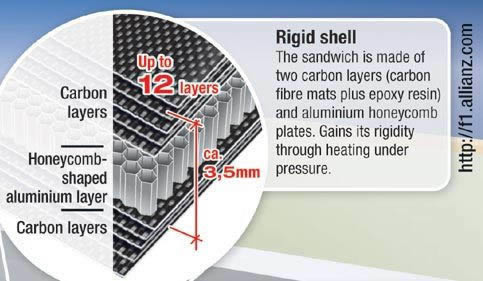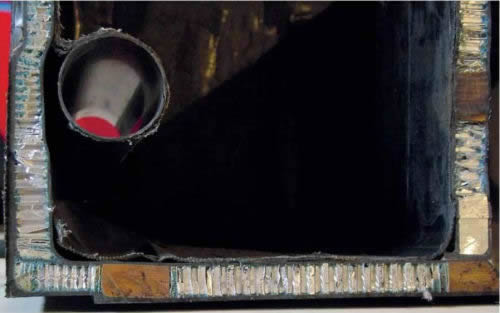Carbon Fiber reinforced
composite materials
Composites are defined as "materials in which two or more constituents have been brought together to produce a new material consisting of at least two chemically distinct components, with resultant properties significantly different to those of the individual constituents". A more complete description also demand that the constituents must also be present in reasonable proportions. 5% by weight is arbitrary considered to be the minimum. The material must furthermore be considered to be "man made". That is to say it must be produced deliberately by intimate mixing of components. An alloy which forms a distinct two phase microstructure as consequence of solidification or heat treatment would not be therefore be considered as composite. If, on the other hand, ceramic fibres or particles were to be mixed with metal to produce a material consisting of a dispersion of ceramic within the metal, this would be regarded as a composite.
On a microscopic scale composites have two or more chemically distinct phases separated by a distinct interface. This interface has a major influence on properties of composite material. Continuous phase is known as matrix. Generally the properties of matrix are greatly improved by incorporating another constituent to produce a composite. A composite may have a ceramic, metallic or polymeric matrix. The second phase is referred as the reinforcement as it enhance the properties of matrix and in most cases the reinforcement is harder, stronger and stiffer then the matrix.
Fiber reinforced composite materials can be divided into two main categories normally referred to as short fiber reinforced materials and continuous fiber reinforced materials.
Continuous reinforced materials will often constitute a layered or laminated structure. The woven and continuous fiber styles are typically available in a variety of forms, being pre-impregnated with the given matrix (resin), dry, unidirectional tapes of various widths, plain weave, harness satins, braided, and stitched.
The short and long fibers are typically employed in compression molding and sheet molding operations. These come in the form of flakes, chips, and random mate (which can also be made from a continuous fiber laid in random fashion until the desired thickness of the ply / laminate is achieved).
Carbon fiber reinforced plastic (CFRP or CRP), is a very strong, light and expensive composite material or fiber reinforced plastic. Similar to glass-reinforced plastic, sometimes known by the name fiberglass, the composite material is commonly referred to by the name of its reinforcing fibers (carbon fiber, glass fiber). The plastic is most often epoxy, but other plastics, such as polyester, vinyl ester or nylon, are also sometimes used.
Some composites contain both carbon fiber and other fibres such as kevlar, aluminium and fiberglass reinforcement. They are known as hybrid composites.v

F1 monocoque - hybrid composite structure
The terms graphite-reinforced plastic or graphite fiber reinforced plastic (GFRP) are also used but less commonly, since glass-(fibre)-reinforced plastic can also be called GFRP.
Carbon fiber composite has many applications in aerospace and automotive fields, as well as in sailboats, and notably in modern bicycles, motorcycles and sport cars, where these qualities are of importance. Improved manufacturing techniques are reducing the costs and time to manufacture making it increasingly common in small consumer goods as well, such as laptop computers, tripods, fishing rods, racquet sports frames.

Comparison of thermal characteristics:
- GFRP Glass Fiber Reinforced Plastics
- CFRP Carbon Fiber Reinforced Plastics
- AFRP Aramid Fiber Reinforced Plastics

Carbon Fiber Reinforced Plastics (CFRP) is superior to steel or glass fiber reinforced plastics (GFRP) in its specific tensile strength and specific elastic modulus (specific rigidity). That is to say, CFRP is "Light in Weight and Strong" in its mechanical performances. Composites are largely unrivalled as a material for impact absorption, with a specific energy absorption (SEA, measured in kJ per kg of material used) far higher than their metallic counterparts – providing sufficient optimisation.
The decision to use CFRP for impact absorption is a fairly easy one. Comparing the SEA-s of various materials, steels achieve about 12 kJ/kg while aluminium reaches around 20k J/kg. However, a well-optimised carbon fibre structure (one with an optimised lay-up/fibre orientation and component geometry) can absorb anything from 40 kJ/kg up to 70 kJ/kg in a highly refined and tested design.
Suffice to say, from a safety perspective, CFRP does not look likely to be superseded as Formula One’s material of choice any time soon.

Composite honeycomb structure
Composite Materials Technology in Formula 1 Motor Racing (PDF) (Honda Racing F1, Gary Savage, 2008)






